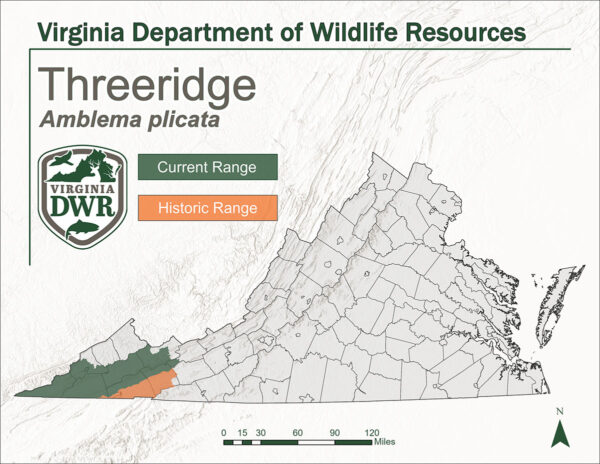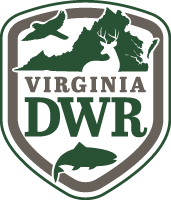A young Threeridge encountered during a survey on the Clinch River. ©Photo by Kayla Howard - DWR
A Threeridge showing prominent growth rings. ©Photo by Tim Lane - DWR
Fact File
Scientific Name: Amblema plicata
Classification: Freshwater Mussel, Family Unionidae
Conservation Status:
- Species of Greatest Conservation Need-Tier 3b on the Virginia Wildlife Action Plan
Size: 178 mm
Life Span: 54 years
Identifying Characteristics
- Shell is large, thick, and squarish in shape
- Both the anterior and posterior ends are round
- The ventral margin is slightly curved
- Three or more distinct ridges are present on the posterior half of the shell
- The outer covering of the shell (periostracum) varies from yellowish-green to green in color, but darkens to black with age
- The inner portion of the shell (nacre) is white and iridescent, sometimes containing shades of pink or purple
Habitat
The Threeridge lives in a variety of habitats, from small streams to large rivers, as well as reservoirs and lakes. It can be found in a variety of substrates ranging from clay, mud, sand, gravel, to a sand-gravel mixture.
Distribution
The Threeridge occurs throughout the upper Tennessee River basin in southwest Virginia, where it is encountered in the Clinch, Powell, and North Fork Holston River watersheds. In 2024, shell material was observed in the Middle Fork Holston River, the first report of this species in the watershed.

Life History
Freshwater mussels have a very unique life cycle. Parasitic larvae, called glochidia, develop in the gills of the female mussel. Once mature, the glochidia are expelled from the gills of the mussel and must attach to the gills of a suitable host fish, where they complete their transformation into a juvenile mussel. They then detach from the fish and begin their free-living existence on the river bottom.
Some freshwater mussels are host-specialists, meaning that metamorphosis can only occur on a limited number of closely related fish species, while others are host-generalists, with the ability to complete their life cycle using many different species. The Threeridge uses a variety of fish species including Black Bass (Micropterus spp.), Crappie (Pomoxis spp.), Perch (Perca spp.), Sunfish (Lepomis spp.), and True Bass (Morone spp.).
Special Considerations
Freshwater mussels are extremely imperiled organisms. DWR regulates the take and possession of freshwater mussels occurring within the state. It is unlawful to take mussels from any inland waters in the Commonwealth except as provided for in §§ 29.1-418 and 29.1-568 of the Code of Virginia.
Last updated: November 25, 2025
The Virginia Department of Wildlife Resources Species Profile Database serves as a repository of information for Virginia’s fish and wildlife species. The database is managed and curated by the Wildlife Information and Environmental Services (WIES) program. Species profile data, distribution information, and photography is generated by the Virginia Department of Wildlife Resources, State and Federal agencies, Collection Permittees, and other trusted partners. This product is not suitable for legal, engineering, or surveying use. The Virginia Department of Wildlife Resources does not accept responsibility for any missing data, inaccuracies, or other errors which may exist. In accordance with the terms of service for this product, you agree to this disclaimer.

